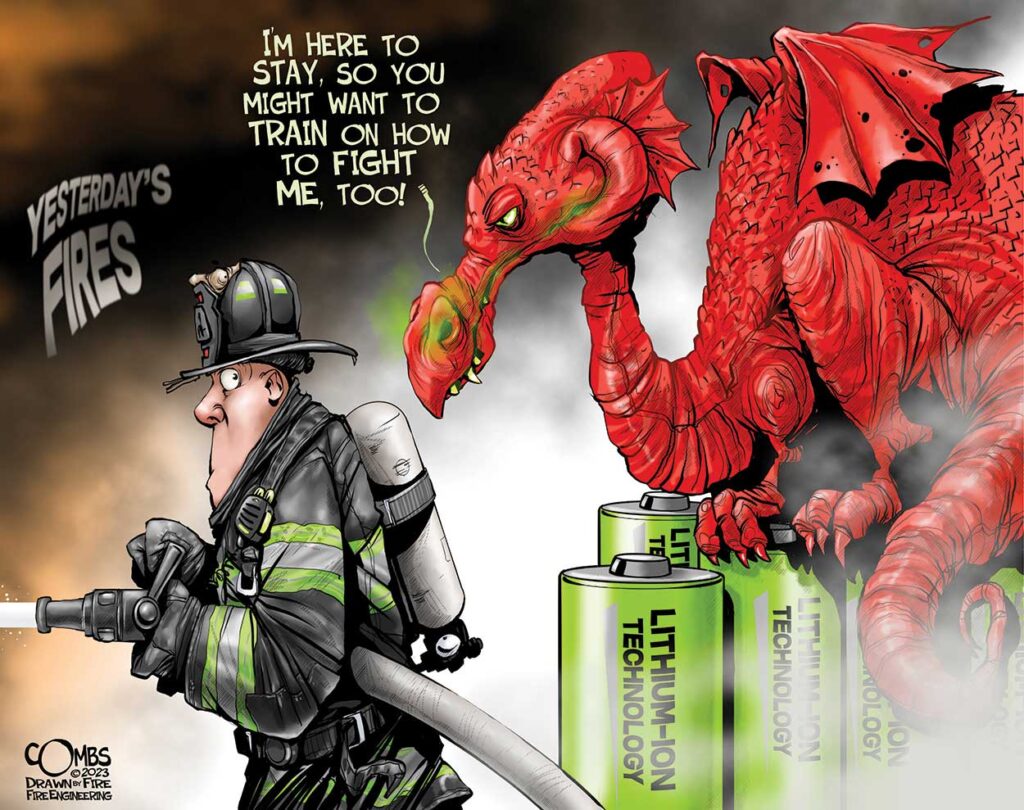Lithium-Ion Batteries: It’s Not a Matter of IF but WHEN

Art by Paul Combs
Comments by Matthew Paglione, Fire Department of New York
Advancements in new battery technology have brought remarkable benefits to society, but they are not without challenges. The availability of black market batteries and knockoff chargers has enticed consumers with their cheap prices, often leading to compromises in safety. Furthermore, some individuals tamper with mobility devices to enhance performance without realizing the dangers they may be exposing themselves to. Damaged batteries can also lead to failures, resulting in hazardous incidents. The increasing popularity of these devices has brought this issue from urban centers to rural areas. Regrettably, a lack of public education has led to a lack of respect for the potential risks associated with lithium-ion batteries.
- Rural Structure Fire Unexpectedly Involves Lithium-Ion Batteries
- The Lithium-Ion Revolution
- Lithium-Ion Batteries: The 18650
- Summer Shenanigans: Mike Ciampo on lithium-ion batteries
This article is meant for the companies on the initial response and aims to address common issues that companies dealing with these batteries may encounter and need to be aware of. It’s essential to keep in mind that information on this technology is rapidly evolving as we learn what works and what doesn’t.
Ensuring Proper Safety Measures:
- One of the most critical aspects is to prioritize the use of personal protective equipment (PPE) and self-contained breathing apparatus (SCBA) when dealing with lithium-ion battery incidents. Regardless of whether the batteries are in thermal runaway or actively emitting flames, wearing proper protective gear is vital. The toxic gas mixture released during such incidents, including hydrogen, carbon monoxide, and carbon dioxide, poses significant health risks. To minimize exposure, firefighters must be on air before engaging with the batteries, as the time to “mask up” is minimal, often less than 10 seconds. After a fire involving a lithium-ion battery, proper gear decontamination is highly encouraged, and firefighters should consider filling out exposure reports. Moreover, these fires emit an intense heat, reaching over 3000°F, making it essential to wear hoods up and ear flaps down for added protection.
Charging Locations and Victim Removal:
- Mobility devices are frequently charged near entrance/egress points, which presents challenges for occupants and rescue teams during firefighting operations. Alternative methods of victim removal must be considered, as fire can cut off escape routes. It’s crucial to apply copious amounts of water before passing by these devices to reduce the risk of reignition. In some cases, positioning a second hoseline to continue cooling the device while the first line advances deeper into the IDLH (Immediately Dangerous to Life or Health) environment may be necessary. As these devices are often charged close to the ground, firefighters should pay attention to hose advancement to prevent lines from being burnt through. If feasible, remove the involved device to the exterior through a door or window, considering the safety of individuals nearby. For mid or high-rise buildings, moving the device to a bathtub filled with water is recommended. Note that the device could still have a reaction even when submerged in water, so caution is essential. Never attempt to remove the device via an elevator to prevent further hazards.
Hazards During Overhaul:
- One of the most significant challenges arises during the overhaul stage and after the fire has been extinguished. Lithium-ion battery packs consist of multiple individual cells (similar to AA batteries), and when one or a few cells explode, they can propel the others around the room like projectiles. This creates a dangerous situation during overhaul. Cells damaged in the incident may go into thermal runaway and catch fire days or even weeks after the fire has been controlled and the fire department has left the scene. Therefore, it is advisable to account for each cell in the battery pack before conducting overhaul operations. Although this is a challenging task, knowing the number of cells is crucial. Using a plastic shovel and overpacking the cells in a product like “cellblock” can help contain potential hazards. Consideration should be given that a “watchline” be put in place as these batteries have ignited several days after being compromised.
As lithium-ion batteries continue to power our modern lives, it is crucial to be well-informed about the potential risks they pose and to prioritize safety measures when dealing with them. The dangers these batteries present demand a heightened level of awareness and precautionary steps for emergency responders and the public alike. Through education, training, and continuous research, we can effectively mitigate the risks and create a safer environment in the 21st century’s battery-powered era.
Note: Since I don’t have access to specific regulations or guidelines from your department or organization, some of the details in the article are kept general. Please ensure that the information provided aligns with your department’s standard operating procedures and safety protocols.
Matthew Paglione
L27 Bronx
To see more Drawn By Fire cartoons or to purchase prints, go to: https://paul-combs-studio-7.myshopify.com/
MORE BY PAUL COMBS
- Drawn by Fire: Bring Friends
- Drawn by Fire: You Can’t Hide
- Drawn by Fire: Saving Baby
- Drawn by Fire: Zero Talent

